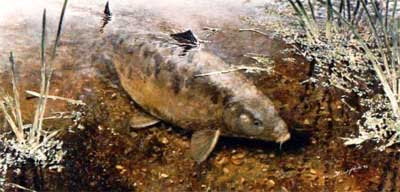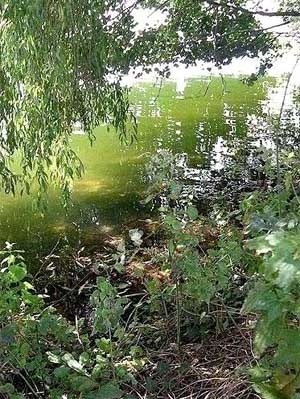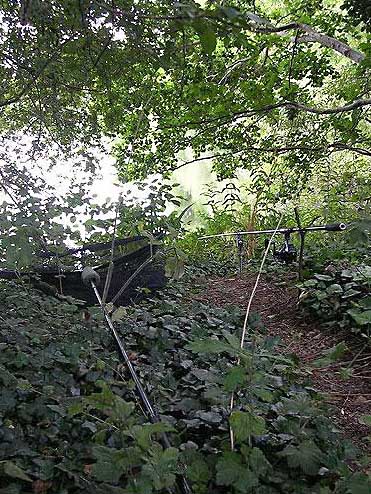It always surprises me how the margins seem to get overlooked. Everyone seems to want to cast to the feature on the horizon, or use the marker rod to find a bar that everyone fishes to out in the middle of the lake, then try reaching it with a marker rod and spod.
Sure, people are always going to catch fish at range and, yes, all these regular spots will produce fish due to the fact that they are fished regularly; the fish get used to seeing lots of bait which is why thy become so called ‘hot spots’.
However, making your own marginal hotspot could give you the edge on the other anglers fishing the lake. Fish naturally patrol the margins due to the fact that most of the lake’s natural fool is generated in the margins; water depths of 6 foot and under can be very rich natural food areas in any lakes, holding plenty of food the most elusive carp cannot resist. Even on the most heavily pressured day ticket waters, I have seen fish confidently grazing around right up against the boards whilst the angler in the next swim, who is only a matter of yards away, is casting 100+ to a fishless feature!
 I am not saying that carp are easy to catch in this situation but a few simple things will certainly help put a fish on the mat. When checking the margins, always try your hardest to blend in, keeping a low profile and entering the area you are checking out from either side using bank side vegetation for cover so you’re not detected by any fish in the margin. If you do find the only way in to your vantage point is through the middle, keep as low to the ground as possible to avoid detection from the fish.
I am not saying that carp are easy to catch in this situation but a few simple things will certainly help put a fish on the mat. When checking the margins, always try your hardest to blend in, keeping a low profile and entering the area you are checking out from either side using bank side vegetation for cover so you’re not detected by any fish in the margin. If you do find the only way in to your vantage point is through the middle, keep as low to the ground as possible to avoid detection from the fish.
Remember, if you can see them, the chances are they will be able to see you too if you are not careful. If you do not own a pair of Polaroid sun glasses, you really could be missing out, there are several pairs available that will deal with all angling situations, however the majority of the time I use grey lenses and amber for dusk and dawn stalking. The different colours help filter the strength of light at certain parts of the day. Not only do they remove the glare from the water on a bright day so you can spot the fish, they also give you the edge to see that bit further out, enabling you to determine what the bottom is looking like.
It is also a really good idea to wear a cap; again, this helps eliminate some glare, but it also stops the light catching your glasses. Without this you may flash a warning to the fish you’re trying to spot with the glint off your glasses.
I was recently fishing a very tricky water where the fish are rarely visible. Most of the time you sit behind your rods wondering whether there are any fish in there! They rarely roll, rarely crash out or show signs of fizzing. These fish have mastered the art of being elusive in every sense of the word.
I’d had a blank night, the conditions were great; warm, slightly overcast with a gentle southerly wind, coupled with the fact that we had just had an easterly and high pressure front push through. I thought that the fish would be along the tree line where the warm wind was pushing feeding on any natural food that had been pushed into the area by the wind. So, I reeled the rods in, grabbed the Polaroid’s and crept along the margin with a bag of Nutrabaits hemp pellets.
As I crept in to my first viewing spot, I could clearly pick out a good mirror, slowly cruising through the crystal clear water. Whilst containing my excitement, I noticed another fish out to my left. As soon as the fish had moved through the area, I threw a couple of handfuls of pellets onto the spot, slowly backed away and continued my short stroll. Although I didn’t see any more fish, I did bait two other spots with the intention of leaving them for a while to return later to see if any fish had moved in.
 I made my way back to my first baited area, keeping as low to the ground as possible, getting myself into position. I lifted my nose above the cover and to my delight, found the two fish I had seen earlier eating the hemp pellets. I waited for them to polish the hemp pellets off and move out of the area, before throwing some more in, as I didn’t want to spook them. I edged back from the spot and hurried back around to my swim.
I made my way back to my first baited area, keeping as low to the ground as possible, getting myself into position. I lifted my nose above the cover and to my delight, found the two fish I had seen earlier eating the hemp pellets. I waited for them to polish the hemp pellets off and move out of the area, before throwing some more in, as I didn’t want to spook them. I edged back from the spot and hurried back around to my swim.
The beauty of finding fish at close quarters like this is that it gives you lots of options. If you can possibly cast a bait in from your swim, knowing that the fish have briefly moved out of the area, laying the trap for their return, or as I did, you can set up a stalking rod. It’s very easy to sit behind the buzzers waiting for them to sound, but to actually have eye contact with a fish picking your hook bait up literally feet away from you, is too much for me to resist.
I hastily set my little stalking rod up, making the most simplistic rig as fishing at such close quarters I find that this is all that is needed when you can literally see the fish and the hook bait. I decided to use a small size 10 wide gape hook with a short hair held in place by a knotless knot as the hemp pellets are only small and fishing it tight behind the back of the hook would ensure when I saw the fish suck the hook bait into its mouth, the wide gape would be right there with it. I tied the rig approximately 2’ long with 15lb fluorocarbon which is almost invisible in water and heavy so it sinks really well.
When the fish were in the area feeding, it would limit the chance that the line would rise off the bottom and touch them. I attached the rig to the main line and finished it off by wrapping a blob of putty around the size 8 swivel; this would also ensure that the line was pinned to the lake bed when the fish returned. I prefer to use tungsten putty under these circumstances instead of a lead weight on the line, as if the fish gets into weed or snags the putty, it will pull off giving me more of a chance to land the fish. You really don’t need anything complicated in this fishing situation- keep it simple and ensure your line is pinned to the lake bed and the fish will not suspect a thing.
I made my way back to the prepared spots with the most basic of bits in my unhooking mat, just in case I needed to retie anything. As I lowered the tackle into the swim in front of me, I popped my head up to see the two fish had been joined by a couple of others (all mirrors),with the biggest looking at around 30 pounds.
I patiently sat waiting for the moment I could lower my bait into position without spooking the four carp who were now competing for every pellet they could find. I always let the fish move away from the area before placing my bait into position. It’s so easy to jump the gun and try to lay your trap whilst the fish are in the area and spook them.
 It wasn’t long before they had all drifted just out of sight and I had my opportunity to place my bait on the polished gravel bottom. I quickly dipped the hemp pellet hook bait in some hemp glug and lowered in into place, ensuring the putty pulled the rig tight so my line would not be detected when the fish returned and continued to feed. It also would mean if I had a pick up, my strike would directly set the hook. With my bait in position my heart was jumping out of my chest, without a fish in sight.
It wasn’t long before they had all drifted just out of sight and I had my opportunity to place my bait on the polished gravel bottom. I quickly dipped the hemp pellet hook bait in some hemp glug and lowered in into place, ensuring the putty pulled the rig tight so my line would not be detected when the fish returned and continued to feed. It also would mean if I had a pick up, my strike would directly set the hook. With my bait in position my heart was jumping out of my chest, without a fish in sight.
Within a few minutes, one of the smaller fish appeared and started picking the pellets off; it seemed determined to eat as many as possible before its banqueting buddies returned. Out of the corner of my eye, the other 3 fish appeared just as the feeding fish were making a bee line for my hook bait.
The fish extended its lips and engulfed the hemp pellet and I struck the hook into place. The margin erupted as the four fish bolted in different directions. My heart was now doing summersaults and the hard fighting fish powered off into the open water. The fight was amazing and the fish gave me an unbelievable battle before I slid the net under it. With my arms pumped full of lactic acid, I dunked the sling and mat before zeroing the scales.
I have not caught many fish from this lake, but when I pulled the net from around the fish on the mat I knew exactly who I had caught; the fish known to all the regulars as ‘Nelson’. His lack of one eye is certainly made up for by its huge abnormally sized tail. I had heard rumours of how this fish had scrapped and now knew why everyone who had caught it spoke of its power when hooked. The fish tipped the scales around to 21lb 8oz.
Whilst photographing the fish, and sorting out the carnage in my swim that always seems to happen when I catch one, the wind changed and no other fish returned to the area. The obvious thing to do was to move down the other end of the lake to try and see if I could locate them from a different base camp. Unfortunately, although the conditions were still good, none of the fish made the same mistake as Nelson over the next 48 hours and if it wasn’t for that one fish originally giving its where about up that morning, I’d have probably blanked!
So, the next time you’re out and there is a warm wind pushing into the margins, check them out. You never know what you may find and you really have nothing to lose.
Ian Gemson
Visit Ian’s SmartCarping website for Information on his services.













